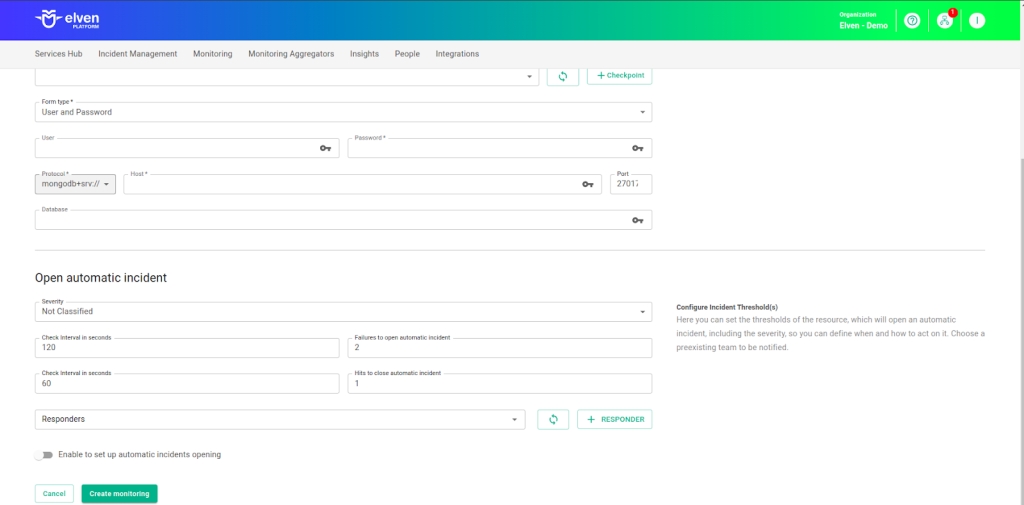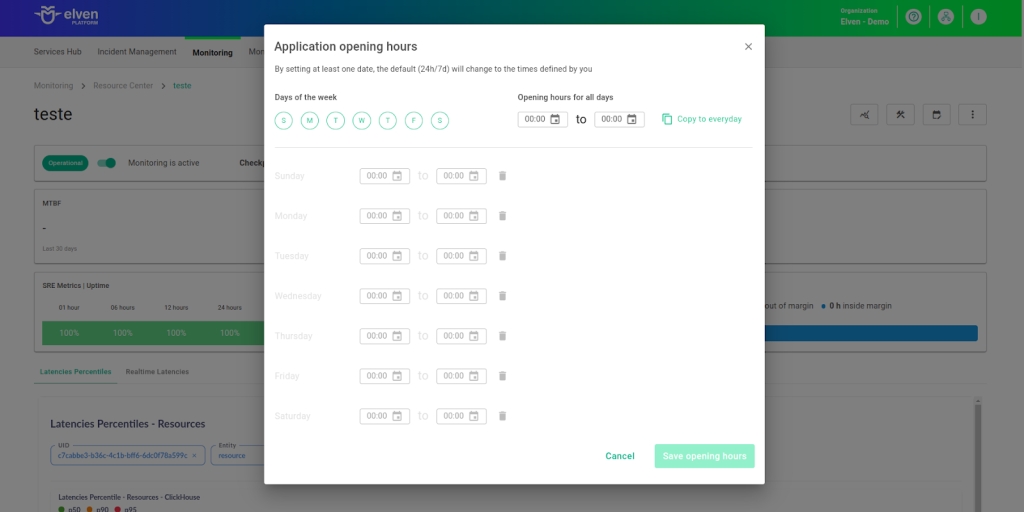Guide to Configuring MongoDB Database Monitoring on the Elven Platform
The MongoDB Monitor from the Elven Platform enables checks based on key queries in MongoDB. This feature helps you configure continuous checks, set alerts, and define thresholds for automatic incident opening, ensuring you're quickly informed of any irregularities in connectivity or service performance.
MongoDB is an open-source NoSQL database management system, known for its flexibility, scalability, and high performance. It stores data in BSON documents (a binary extension of JSON), allowing for a dynamic and easily adaptable structure. MongoDB offers advanced capabilities such as real-time queries, large-scale data analysis, and support for replication and distribution to ensure high availability.
Widely used in web applications, big data systems, and IoT platforms, MongoDB is valued for its ability to scale horizontally, its integration with various analytics tools, and its flexibility in managing unstructured data.
Accessing MongoDB Monitoring
Navigate to the main menu and click on Services Hub.
Under Database, select the MongoDB item.

Monitoring Configuration
Monitoring your service availability has never been easier. Start by giving a clear name to the resource you want to track (Resource Name) to make identification easier. Then, adjust the Interval between checks and the Timeout for responses.
Select where the monitoring agent is located (Checkpoint Cloud) by choosing an Environment. If one doesn’t exist, you can create it using + Checkpoint. After this setup, in Form Type, you can choose between User and Password or Healthcheck URL.
For User and Password, you must provide the Username and Password, which are the database access credentials. Then, enter the server address in the Host field, along with the Protocol and Port—which defaults to 27017, but can be adjusted if your database uses a different port.
In the Protocol field, you can choose between:
mongodb:// – the classic protocol for connecting directly to MongoDB servers, where you specify server addresses and ports. Ideal for local setups or private clusters.
mongodb+srv:// – simplifies connections to MongoDB Atlas by using DNS to automatically discover all cluster nodes. Perfect for cloud-based environments seeking a simpler, hassle-free experience.
In the Database field, specify the name of the database to be monitored. If using Healthcheck URL, simply enter the URL of the resource to be monitored.
Remember: the Host and Healthcheck URL fields only accept URLs. If you need to use an IP address, it must be stored in a Secret to ensure the security and organization of your information.

Automatic Incident Opening
You can configure automatic incident opening to ensure a quick response to critical issues. To begin, define the incident severity, allowing you to prioritize according to urgency. Next, adjust the Check Interval, specifying the check frequency in seconds to continuously monitor the resource. This helps ensure you're always one step ahead, detecting problems as soon as they arise.
Additionally, select the team to be notified whenever an incident occurs and enable the "Enable to set up automatic incidents opening" option to ensure the configuration is active. With this setup, the platform automates incident management, making the response process faster and more efficient, without the need for manual intervention. This ensures your team is always ready to resolve any issue with speed and precision.

Maintenance Window
We also have the Maintenance Window, an essential feature for managing planned maintenance periods in your application. During this interval, checks are temporarily paused, preventing monitoring, alerts, and notifications from being triggered while you perform updates or adjustments. This allows maintenance to proceed smoothly, without generating unnecessary notifications or false alarms, ensuring your operations continue in an orderly manner without unexpected interruptions in performance reports.
For example, imagine you need to update the payment system of an e-commerce platform, making backend adjustments such as installing new security certificates. To do this, you can configure a Maintenance Window for a specific time, such as 12/13/2024, from 14:00 to 14:30. During this period, the Elven Platform suspends checks, preventing the monitoring system from logging temporary failures or triggering false alerts. This way, you can make the necessary changes calmly, knowing that the monitoring system will not be impacted during maintenance.
This approach ensures that the update is carried out in an organized way, without affecting the user experience or generating unwanted notifications.

Application Opening Hours
You can also rely on the Application Opening Hours feature, which allows you to configure your application's operating hours. This functionality is essential for customizing monitoring based on the periods when your application is actually active, avoiding alerts and notifications outside of business hours. This makes monitoring more aligned with your business’s real needs, ensuring more accurate reports and efficient management.
For example, imagine your application operates only from Monday to Friday, 09:00 to 18:00. You can configure Application Opening Hours to reflect this schedule by specifying the days and time periods of operation. With this setup, the Elven Platform automatically disables checks outside of these hours, preventing the logging of failures that don’t affect end users and avoiding unnecessary alerts.
This approach optimizes performance analysis, focusing only on relevant periods and providing a clearer view of your application's health during its operating hours.

Glossary of Technical Terms
MongoDB: An open-source NoSQL database management system designed to handle large volumes of unstructured and semi-structured data. Known for its flexibility, horizontal scalability, and high performance, MongoDB uses a document-based data model built on JSON, making it easy to store and query complex data. Widely used in web applications, agile development environments, and big data projects, MongoDB stands out for its efficient scalability, seamless integration with various platforms, and support for real-time distributed data.
mongodb://: A protocol used for direct connection to MongoDB servers, explicitly specifying IP addresses or server domains and ports. Commonly used in local installations or private clusters.
mongodb+srv://: A protocol used to connect to MongoDB Atlas clusters, simplifying connection setup by omitting server address details and using DNS to automatically resolve the list of cluster nodes. Ideal for cloud environments.
Interval: The time interval between automatic checks performed during monitoring.
Timeout: The maximum time allowed for the monitoring system to receive a response from the monitored resource before registering a failure.
Checkpoint Cloud: The location where the monitoring agent is hosted, which can be a pre-existing environment or one created by the user.
Host: The URL address of the monitored resource. If an IP address is required, it should be stored in a Secret for enhanced security.
Secret: A resource used to store sensitive information, such as IP addresses or credentials, ensuring security and organization.
Enable to set up automatic incidents opening: An option that, when enabled, activates automatic incident opening upon detection of critical issues.
Severity: The level of criticality assigned to an incident, allowing it to be prioritized based on urgency.
Check Interval: The time interval, in seconds, for performing continuous checks on the monitored resource.
Maintenance Window: A feature that temporarily pauses monitoring, alerts, and notifications during planned maintenance periods.
Application Opening Hours: A configuration that defines the operating hours of the application, aligning monitoring with active periods and avoiding alerts outside those hours.
Last updated
Was this helpful?

